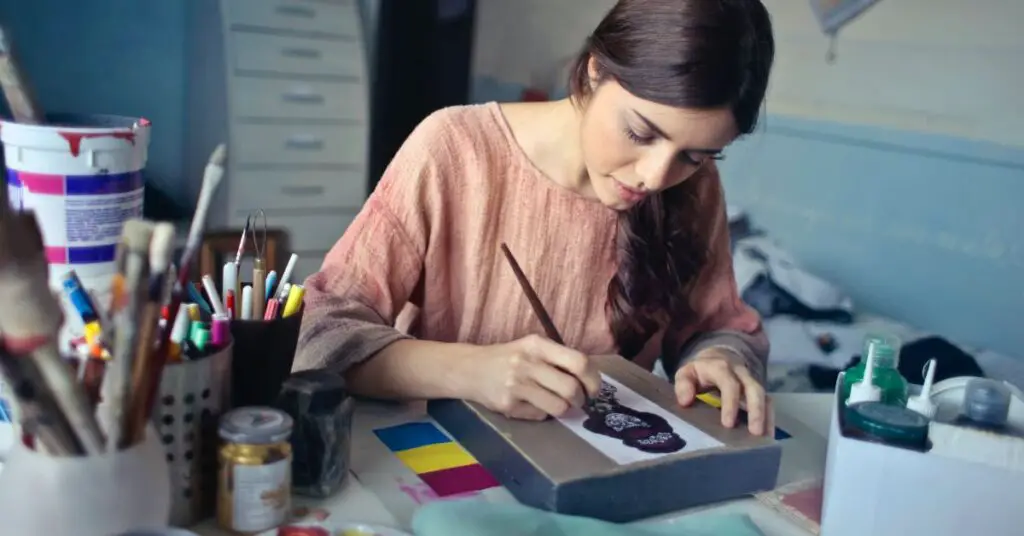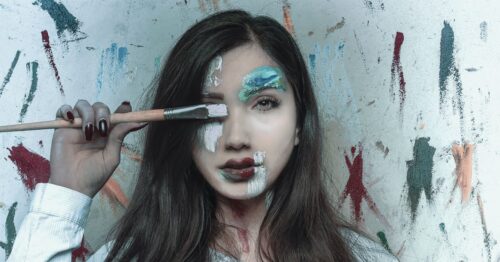Imagination and Creativity Explained: How Neurodiversity Can Fuel the Arts
Autism spectrum disorder affects how individuals communicate, interact, and process information. While autism has its challenges, many autistic people also have unique imagination and creativity that empower them to succeed as artists and innovators.
Autism creativity explained through emerging research reveals fascinating connections between autism traits, original thinking, and gifts in the arts.
Creativity Explained: Autism Creative Thinking and Imagination
 The autistic brain is wired differently than neurotypical brains. Neuroimaging shows autistic individuals have variations in brain structure and function compared to non-autistic peers.
The autistic brain is wired differently than neurotypical brains. Neuroimaging shows autistic individuals have variations in brain structure and function compared to non-autistic peers.
Certain aspects of autistic neurology lend themselves well to imagination and creativity. Autistic people tend to have enhanced perceptual functioning, excelling at recognizing small details and patterns. This fuels talents in visual arts, music, math, and programming.
Additionally, autistic individuals often think in innovative ways thanks to differences in their cognitive flexibility, ability to switch between ideas, and frontal lobe functions. Their brains make connections between concepts that others would not.
This novel thinking and autism creative thinking, along with intense interests, fuels out-of-the-box imagination.
Autistic people also commonly have a preference for visual thinking over verbal skills. Visual learning styles involve creating vivid mental images and pictures. This grants advantages in visually based arts like painting, photography, film, and design.
Overall, as a possible explanation for imagination and creativity explained, the autistic brain is wired for originality. While autistic individuals face struggles in some areas, their neurology equips them with cognitive strengths suited for the creative arena.
Autism Creative Thinking: Prominent Artists on the Spectrum Showcase Imagination
When given the right opportunities and support, many autistic individuals channel their gifts into groundbreaking art and design.
Some prominent suspected or diagnosed autistic artists include (as mentioned in various autism articles):
- Author Virginia Woolf – Created experimental novels like Mrs. Dalloway and To the Lighthouse. Her modernist writing style influenced many later writers.
- Animal scientist Temple Grandin – In addition to designing more humane livestock equipment, she is a talented visual artist and has created autism-themed paintings.
- Painter Stephen Wiltshire – Known for remarkably detailed cityscape drawings completed from memory after a single helicopter ride over a city. His ability to transform scenes into art is unmatched.
- Satoshi Tajiri – The creator of Pokémon, Tajiri had a childhood fixation on collecting insects that inspired his innovative video game empire.
- Dani Alexis – A prolific novelist and poet who weaves autism themes into speculative fiction stories. She eloquently expresses the autistic experience through creative writing.
These individuals demonstrate how conditions like autism, which utilizes systematic thinking and intense focus, can enable extraordinary artistic accomplishments.
Imagination and Creativity Explained: Autism Traits that Foster Artistic Strengths
 Several cognitive and behavioral traits associated with autism give advantages in developing artistic skills and creations. These include:
Several cognitive and behavioral traits associated with autism give advantages in developing artistic skills and creations. These include:
- Attention to Detail
Autistic brains excel at recognizing small details others overlook. Artists like Stephen Wiltshire leverage this ability to portray scenes with photorealistic precision. Similarly, the eye for patterns helps autistic musicians master the intricate nuances of a musical composition. - Hyperfocus
When interested in a topic, autistic individuals can enter a state of extreme, laser-like focus. This hyperfocus allows artists to direct all their mental energy into developing skills, planning creative projects, and entering flow states. Hyperfocus powers greatly accelerated learning. - Imagination
While autistics often struggle with pretend play in childhood, many retain a vibrant imagination. Temple Grandin, for example, visualized her acclaimed humane cattle equipment designs in full detail before bringing them to life. Combining imagination with systematic thinking brings creativity. - Nonconventional Thinking
Because they see the world from varied vantage points, autistic artists invent creative work outside mainstream conventions. They follow their own muse rather than social expectations. This autism creative thinking enables revolutionary innovations in form, style, and subject matter. - Pattern Recognition
The autistic brain intuitively recognizes patterns in everything from numbers to music to brush strokes. Identifying meaningful patterns across superficially different domains fuels creativity and metaphorical thinking – perfect for symbolism in art and literature. - Repetitive Practice
Mastering artistic skills requires repetitive rehearsal and practice. Autistic individuals’ proclivity for routine and repetition gives an edge in deliberately practicing creative techniques until they become second nature. Interests can drive intense practice and a healthy autistic obsession. - Visual Thinking
Many autistic individuals rely more heavily on visual rather than verbal thinking as a notion of creativity explained. This lends advantages in visual arts like painting, film, photography, and design. Autistic artists excel at thinking in images, scenes, and spatial relationships. - Systemizing
Strong systemizing skills – the drive to construct rule-based systems – help artists invent original but coherent forms, styles, structures, and techniques. Musicians and writers benefit from systemizing to create symbolism, themes, and other patterns within a work.
The Independence of Autistic Artists to Showcase Imagination and Creativity
Along with cognitive traits, social and behavioral attributes associated with autism empower self-driven creativity.
Autistic artists are less compelled to follow mainstream trends just to fit in socially. This enables them to freely explore their inner world rather than bending to conventions or social pressures. Their creativity comes from within.
Additionally, reduced concern for social approval grants freedom to create without worrying about outside perceptions as an aspect of creativity explained. Autistic artists can feel comfortable ignoring stale rules and express their true vision.
By leveraging these strengths while getting support in areas of challenge, autistic artists empower some of the most visionary innovations in the arts. In terms of creativity explained, it’s as simple as understanding that neurodiversity can strengthen creativity.
Promoting the Potential for Autism Creative Thinking
Society should recognize autism’s creative gifts and provide more opportunities for those individuals on the spectrum to cultivate artistic paths.
There are numerous ways parents, teachers, and mentors can nurture autistic people’s creative potential.
9 Ways to Nurture Autism and Imagination
- Encourage autistic children to freely explore artistic activities of interest without judgement. Avoid redirecting interests.
- Provide accommodations like quiet workspaces to help autistic artists minimize distractions and fully engage in the creative process.
- Teach skills explicitly and systematically while allowing opportunities for self-directed learning projects.
- Introduce and demystify “rules” of art while reassuring that original approaches have value.
- Offer feedback that builds on strengths and makes suggestions gently to retain self-confidence.
- Adjust expectations around art instruction to suit autistic learning and interaction styles.
- Share examples of renowned autistic artists to provide diverse role models.
- Foster collaboration and mentorships between autistic students and professional autistic artists.
- Advocate for more inclusive arts education, industry internships, and hiring to create paths to creative careers.
In terms of autism creativity explained, with supportive aid from teachers, parents, and the artistic community, autistic individuals can transform their visionary talents into fulfilling, successful ventures in the arts.
My Own Autism Creative Thinking Explained
 I think autism has made me more creative. I’m not much of a musician or a painter but I have always been good at writing. Since I was little, my teachers and others have told me that my writing style and my ideas to write have been great.
I think autism has made me more creative. I’m not much of a musician or a painter but I have always been good at writing. Since I was little, my teachers and others have told me that my writing style and my ideas to write have been great.
This creative talent is what led to making this blog in the first place. So, in terms of my own creativity explained, I’m glad I was born with autism because it led me to make this my life path.
I believe this creativity explained is proof that autism can help you make a successful career in whatever creative field you want. I want to take my writing talent farther in the future.
I want to write a book, and right now I’m thinking something sci-fi, maybe something inspired by Isaac Asimov (known for I, Robot and Foundation among many others).
So, autism clearly can be a great asset for creative thinking and work so whatever artistic talent you may have you can take it as far as you want.
While autism poses challenges in some areas, autistic individual’s unique cognitive wiring also grants creative superpowers. Autism cultivates vital skills like attention to detail, intense focus, nonconventional thinking, imagination, pattern recognition, and affinity for visual media.
Autistic artists integrate these strengths to share original perspectives through their work. By providing development opportunities and encouragement, society can empower autistic people to make their mark as tomorrow’s creative innovators.
Autism in Adults: Living, Learning, and Overcoming Challenges for a Fulfilled Life
Autism in adults requires additional support and coping skills to achieve independence in today’s world. Learn more about ways adults can live fulfilled lives and the challenges they face.
- Autism and Independence: 7 Skills That Empower Individuals to Thrive
- Dangers of Social Media Addiction: How To Leave the Screens And Face the Real World
- Autism Volunteer Opportunities: 5 Ways Helping Others Fosters Acceptance
- 8 Heartfelt Ways Autism Emotional Support Animals Transform Lives
- Autism in the Future: Optimism for Improved Perception and Embracement
- Autism and AI: 7 Discoveries About the Surprise Pairing and Profound Impact
- Are You An Adult With Autism? Here Are 6 Signs
- Autism After High School: Is College the Next Step?
- Autism vs Asperger’s Syndrome: What You Need to Know
- Autism Disclosure: Is Revealing Your Disorder Helpful or Hurtful?
- Work and Autism: What Employers Should Know About Hiring People Like Me
- Drivers with Autism Can Achieve Success Behind the Wheel